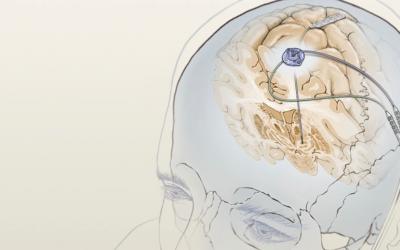
Funding
NIH/NINDS R01-NS090913-05
The motor network in Parkinson's disease: mechanisms of therapy
The goal is to understand the motor network in movement disorders and the mechanism of chronic therapeutic interventions in humans, at very fast time scales, using multisite invasive recording of local field potentials (LFPs) and electrocorticography (ECoG). To perform longitudinal studies we utilize a novel totally implanted bidirectional neural interface (Summit RC+S) attached to permanent cortical and basal ganglia electrodes, in humans undergoing deep bran stimulation therapy.
NIH/NINDS UH3 NS100544
Closed loop deep brain stimulation for Parkinson's disease
The goal of this project is to perform a small clinical trial of closed loop deep brain stimulation in Parkinson’s disease. Patients are implanted with a second-generation bidirectional neural interface, Activa RC+S, attached to permanent cortical and basal ganglia electrodes. The study will address key questions needed to inform subsequent design of neural interfaces, including the utility of cortical versus basal ganglia signal detection, and selection of frequency bands for optimal control signals.
NIH/NIMH 1R01MH114854-01(Lead Institution: Baylor College of Medicine)
Neuroethics of aDBS Systems Targeting Neuropsychiatric and Movement Disorders
This study aims to identify and empirically examine pressing neuroethics issues related to the use of adaptive deep brain stimulation (aDBS) systems in clinical trials for the treatment of neuropsychiatric and movement disorders.
The Michael J. Fox Foundation for Parkinson's Research
Neurophysiological Signatures of Depression and Impulsivity
The aim of this project is to identify neurophysiological signatures of depression and impulsivity in basal ganglia and cortex, using an investigational device that allows therapeutic stimulation and chronic brain recordings. The device is attached to two permanent electrodes, one placed over the orbitofrontal cortex (OFC)/inferior frontal gyrus (IFG) and the other in the subthalamic nucleus (STN). Brain signals are recorded while modulating the symptom severity with dopaminergic medication. The effect of cortical stimulation on both symptoms severity and brain signals is also being studied.
NIH/NIMH R21-MH120810
Fabrication and testing of next generation cortical paddle leads for bidirectional neural interfaces
The overall goal of the project is to fabricate prototype permanent arrays with similarly favorable mechanical properties as the temporary arrays, confirm that the arrays can record neural signals when attached to bidirectional neural interface, can be easily inserted and steered in humans through a convexity burr hole, and provide human ECoG recordings that are comparable to those of temporary arrays. The LLNL team will create prototypes of four and eight contact arrays configured to attach to multiple types of neural interfaces, and benchtop test these for structural integrity.
NIH/NINDS U24 NS113637
Accelerating Dissemination of Implantable Neurotechnology for Clinical Research
This project aims to disseminate critical regulatory and technical infrastructure for the use of bidirectional (sense and stimulate) neural interfaces. Tools include a set of software applications that allow bidirectional implantable interfaces to be used in humans for chronic brain sensing, real-time analytics, and adaptive stimulation in the home environment, and templates for regulatory documents needed by new users of bidirectional neural interfaces, to ensure compliance with FDA regulations.
Past Funding Sources
Defense Advanced Research Projects Agency (DARPA)
Unlearning Neural Systems Dysfunction in Neuropsychiatric disorders
This large multi-PI contract is part of the White House Brain Initiative. The overall goal is to understand brain circuitry underlying depression, anxiety, chronic pain, addiction, and borderline personality disorder, and to develop new therapies for these conditions based on stimulation-induced brain plasticity in combination with cognitive training. The Starr lab part of the grant, “Basal ganglia-frontal circuit function and dysfunction in neuropsychiatric disease” focuses on analysis of prefrontal/basal ganglia circuits mediating nonmotor (psychiatric) fluctuations in Parkinson’s disease.
Dystonia Medical Research Foundation

